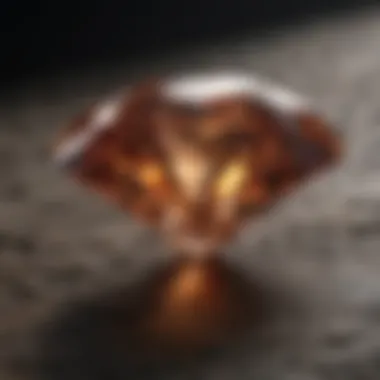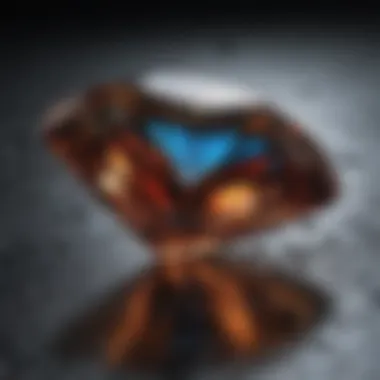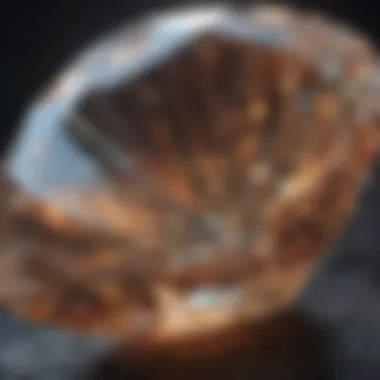Unraveling the Enigmatic Diamond Streak Colors: A Scientific Exploration


Rock and Fossil Identification
Diamonds are revered for their brilliance, but their streak colors can also hold intriguing secrets. When examining diamond streak colors, it's crucial to understand the science behind these hues and how they are influenced by various factors. The types of surfaces diamonds are rubbed on, the pressure applied, and even the temperature can all contribute to the colors left behind. In addition, the chemical composition of the diamond itself plays a significant role. Analyzing these factors can provide valuable insight into the origin and characteristics of diamonds.
Geological Significance
Exploring the geological significance of diamond streak colors unveils a fascinating journey through the Earth's processes. As diamonds form deep within the Earth's mantle under immense pressure and heat, they carry clues about the geological history of their origins. By studying diamond streak colors in relation to geological formations and processes, researchers can glean valuable information about the environments in which these precious gemstones were created. This understanding not only enhances our knowledge of diamonds but also sheds light on the larger geological forces at play.
Historical Insights
Delving into the historical significance of diamond streak colors unveils a tapestry of cultural reverence and fascination. Throughout history, diamonds have captivated societies worldwide, symbolizing wealth, power, and beauty. By examining the historical contexts in which diamonds with specific streak colors were prized, we can gain a deeper appreciation for the enduring allure of these gemstones. From ancient civilizations to modern-day luxury markets, the historical journey of diamond streak colors reflects the evolving perceptions of beauty and value.
Introduction to Diamond Streak Colors
The realm of diamond streak colors is a trove of fascinating insights awaiting exploration. Understanding the hues that diamonds leave behind when rubbed on specific surfaces is pivotal in unraveling the mysteries of these exquisite gemstones. Delving into the science behind diamond streak colors presents a unique opportunity to deepen one's appreciation for these precious creations of nature. By scrutinizing the subtle nuances of diamond streak colors, enthusiasts can elevate their knowledge and discernment in gemology.
Defining Diamond Streak Colors
Chemical Composition Impact
Within the domain of diamond streak colors, the influence of chemical composition stands as a cornerstone factor shaping the hues exhibited by these gemstones. The specific elemental makeup of diamonds plays a crucial role in determining the spectral palette they manifest when subjected to abrasion. By comprehending the intricate interplay between various elements present in diamonds, gemologists can gain profound insights into the origin of streak colors. The chemical composition impact is a pivotal consideration in the assessment and appraisal of diamonds, offering valuable clues about their formation history and geological provenance.
Crystal Structure Influence
Another fundamental aspect in the elucidation of diamond streak colors is the influence of crystal structure on the resulting hues. The internal arrangement of atoms within diamonds dictates how light interacts with the gemstone, giving rise to a diverse array of streak colors. By scrutinizing the crystal lattice of diamonds, experts can decode the intricate patterns that contribute to the vibrant streak colors observed in these precious stones. Recognizing the significance of crystal structure empowers gemologists to distinguish between different diamond varieties based on their unique streak color signatures.
Light Interaction Effects
The interplay between light and diamond surfaces yields a myriad of captivating effects that define the streak colors left behind by these gemstones. Understanding how light interacts with diamonds on a microscopic level unveils the mesmerizing kaleidoscope of hues that grace their streaks. By unraveling the mysteries of light refraction and reflection within diamonds, experts can decipher the intricate mechanisms that underpin their distinct streak colors. Exploring the nuanced effects of light interaction enhances one's perception of diamond streak colors and enriches the overall gemological experience.
Historical Significance
Ancient Beliefs
Tracing back through the annals of history, diamond streak colors carry profound significance in ancient beliefs and cultural narratives. Across diverse civilizations, diamonds have held mystical connotations attributed to the hues they impart when rubbed on surfaces. Ancient cultures imbued diamond streak colors with symbolic meanings, associating them with concepts of purity, strength, and divine favor. Unraveling the threads of ancient beliefs surrounding diamond streak colors offers a glimpse into the rich tapestry of human fascination with these enigmatic gemstones.


Cultural Perceptions Over Time
The evolving perceptions of diamond streak colors across different epochs reflect shifting cultural sensibilities and aesthetic preferences. Over centuries, diamonds have adorned the crowns of royalty, symbolized eternal love in romantic gestures, and captivated the imagination of artists and poets. The changing attitudes towards diamond streak colors mirror society's evolving values and ideals, hinting at the intricate interplay between luxury, beauty, and status. Exploring the cultural perceptions of diamond streak colors over time unravels a captivating narrative of human creativity, ingenuity, and admiration for the sublime beauty of these treasured gemstones.
Factors Affecting Diamond Streak Colors
Diamond streak colors are a fascinating subject that plays a significant role in understanding the intricate world of gemology. The factors that influence these colors are crucial in gauging the quality and value of diamonds. By exploring the presence of impurities, cut and facet geometry, and environmental conditions, we uncover the secrets behind the mesmerizing hues left by diamonds when rubbed against various surfaces. Understanding these factors is essential for gem enthusiasts, collectors, and professionals in the jewelry industry.
Presence of Impurities
In the realm of diamond streak colors, the presence of impurities such as transition metals and nitrogen content holds paramount importance. Transition metal presence in diamonds impacts their overall coloration, creating unique streak colors that enhance their appeal. These metals introduce distinctive characteristics to diamonds, influencing their hue and intensity. On the other hand, nitrogen content plays a vital role in determining the color spectrum of diamonds, contributing to their rarity and value in the market. Exploring these impurities sheds light on the complex processes that give diamonds their distinctive streak colors, making them highly sought after in the gemstone industry.
Transition Metal Presence
Transition metals are known for their ability to imbue diamonds with striking and vibrant streak colors, making them a popular choice for enhancing the visual aesthetics of these precious gemstones. Their unique chemical properties react with the crystalline structure of diamonds, producing a wide range of colors that captivate the beholder. However, the presence of transition metals also poses certain challenges, impacting the clarity and overall quality of diamonds. Despite these drawbacks, their use remains prevalent due to the unparalleled beauty and allure they bring to diamond streak colors.
Nitrogen Content Impact
Nitrogen content exerts a significant influence on the coloration of diamonds, affecting their hue and saturation levels. Diamonds with varying nitrogen concentrations display a diverse array of streak colors, ranging from subtle tints to intense shades. This impact on diamond color plays a crucial role in determining their market value and desirability among collectors and connoisseurs. Understanding the nuances of nitrogen content in diamonds enhances our appreciation of their unique streak colors and rarity, adding a layer of complexity and sophistication to these prized gemstones.
Cut and Facet Geometry
The cut and facet geometry of diamonds play a vital role in shaping their streak colors and overall visual appeal. The interaction between brilliance and streak color is a key aspect that affects how diamonds reflect and refract light, showcasing their intrinsic beauty. Furthermore, the effects of refraction on diamond streak colors influence how these hues appear under different lighting conditions, adding depth and dimension to their visual appearance. By delving into the intricacies of cut and facet geometry, we unravel the secrets behind the mesmerizing streak colors of diamonds, leading to a deeper appreciation for their value and allure.
Brilliance vs. Streak Color
The interplay between brilliance and streak color is a fascinating phenomenon that enhances the overall visual impact of diamonds. Brilliance refers to the brightness and light performance of diamonds, whereas streak color pertains to the hues that diamonds leave behind when rubbed on surfaces. Balancing brilliance with streak color is essential in creating visually stunning diamonds that exude a captivating allure. However, achieving this harmony requires precise craftsmanship and attention to detail to maximize the aesthetic potential of diamonds and showcase their unique streak colors to full effect.
Effects of Refraction
The effects of refraction on diamond streak colors play a crucial role in how these hues are perceived by the naked eye. Refraction refers to the bending of light as it passes through a diamond, causing the streak colors to shimmer and sparkle under light. Understanding how refraction influences the appearance of diamond streak colors enables gemologists and enthusiasts to appreciate the intricate play of light and color within these precious gemstones. By exploring the effects of refraction, we gain deeper insights into the optical properties of diamonds and the mesmerizing streak colors they exhibit.
Environmental Conditions
Environmental conditions such as temperature and moisture levels also impact the streak colors of diamonds, adding another layer of complexity to their coloration. The temperature influence on diamond streak colors can cause subtle shifts in hue and saturation, highlighting the sensitivity of diamonds to external factors. Similarly, moisture effects can alter the appearance of streak colors, enhancing their brilliance and clarity under optimal conditions. By considering the environmental factors that affect diamond streak colors, we gain a holistic understanding of the intricate processes that govern the formation and visual appeal of these precious gemstones.


Temperature Influence
Temperature influence on diamond streak colors can lead to subtle variations in color intensity and vibrancy, reflecting the thermal sensitivity of these gemstones. Changes in temperature can impact the internal structure of diamonds, affecting how light interacts with their crystalline lattice and producing unique streak colors. By examining the temperature influence on diamond streak colors, we unravel the delicate balance between environmental conditions and the visual aesthetics of diamonds, shedding light on the dynamic nature of these incredible gemstones.
Moisture Effects
Moisture effects play a pivotal role in enhancing the brilliance and clarity of diamond streak colors, elevating their visual appeal and value. Adequate moisture levels can amplify the reflective properties of diamonds, intensifying their streak colors and creating a mesmerizing display of light and color. However, excessive moisture can also impact the durability and longevity of diamonds, necessitating careful consideration when evaluating their streak colors under varying environmental conditions. Understanding the effects of moisture on diamond streak colors offers valuable insights into the nuanced interplay between environmental factors and the intrinsic beauty of these exquisite gemstones.
Notable Diamond Streak Colors in Gemology
In gemology, the study of notable diamond streak colors holds a prominent position due to its significance in understanding the origins and characteristics of these precious gems. Identifying and categorizing different streak colors such as pink, red, blue, green, yellow, and brown plays a crucial role in gemstone evaluation and market demand. By studying these colors, gemologists can determine the presence of impurities, cut quality, and environmental influences affecting a diamond's appearance. Notable diamond streak colors provide valuable insights into the geological processes that shaped these gemstones, enhancing the overall appreciation and comprehension of diamonds.
Pink and Red Streaks
Causes and Rarity
The causes and rarity of pink and red streaks in diamonds are a subject of fascination for gemologists and collectors alike. The unique chemical compositions and structural defects within diamonds contribute to the creation of these vibrant hues. Pink and red diamonds are exceptionally rare, with only a small percentage of diamonds exhibiting these colors naturally. Their rarity is attributed to specific conditions during the diamond formation process, such as the presence of plastic deformation or the absorption of light in the visible spectrum. Gemologists value pink and red diamonds for their distinctiveness and scarcity, making them highly sought after in the world of gemstone appreciation.
Valuation Considerations
When evaluating pink and red diamonds, several factors come into play to determine their value accurately. The intensity of color, purity, and distribution of the streaks greatly influence the overall market price of these gemstones. Pink diamonds with a strong, saturated color and even distribution command higher prices due to their rarity and visual appeal. The rarity of pink and red streaks in diamonds also contributes to their high valuation, with collectors and investors showing a keen interest in acquiring these exceptional gems for their rarity and beauty.
Detection and Evaluation of Diamond Streak Colors
In the exploration of diamond streak colors, the critical aspect of detecting and evaluating these hues is paramount. Understanding the underlying factors that influence the colors left by diamonds when rubbed on surfaces is essential for gemologists and enthusiasts alike. By delving into the methods used to test and assess diamond streak colors, one can unravel the mysteries behind these precious gemstones.
Testing Methods
Streak Plate Techniques
Streak Plate Techniques play a fundamental role in the evaluation of diamond streak colors. This method involves rubbing a diamond against a rough surface to observe the color it leaves behind, aiding in the identification of specific hues and their intensities. The key characteristic of Streak Plate Techniques lies in its simplicity and accessibility, making it a popular choice for gemologists seeking quick analyses of diamond streak colors. Despite its advantages in providing immediate results, Streak Plate Techniques may lack the precision found in more advanced testing methods.
Spectroscopic Analysis
On the other hand, Spectroscopic Analysis offers a more advanced approach to evaluating diamond streak colors. This method involves analyzing the light absorbed and emitted by a diamond to determine its unique spectroscopic signature, which contributes to understanding its color origin and intensity. Spectroscopic Analysis stands out for its accuracy and depth of information, making it a valuable choice for detailed assessments of diamond streak colors. However, this method may require specialized equipment and expertise, adding to the complexity of the evaluation process.


Grading Criteria
Color Consistency Assessment
The Color Consistency Assessment is a crucial aspect of evaluating diamond streak colors, focusing on the uniformity and purity of hues across the surface of a diamond. By assessing the consistency of colors left by a diamond when rubbed on different surfaces, gemologists can determine the quality and integrity of the gemstone's color profile. This assessment provides valuable insights into the origin and treatment of diamond streak colors, helping in valuation and authentication processes.
Clarity Impact
Conversely, the Clarity Impact refers to the evaluation of how the clarity of a diamond influences its streak color appearance. Clarity characteristics such as inclusions or blemishes can interact with light and affect the perceived color of the streak left by a diamond. Understanding the clarity impact on streak colors is essential in determining the overall quality and value of a diamond, providing key information for gemological assessments.
Industry Applications
Jewelry Design Considerations
In the realm of jewelry design, considerations of diamond streak colors play a significant role in creating visually striking pieces. The unique hues and patterns left by diamonds can inspire creative designs, guiding artisans in showcasing the beauty of these gemstones. By incorporating specific streak colors into jewelry pieces, designers can enhance the aesthetic appeal and exclusivity of their creations, offering customers distinctive and alluring jewelry options.
Authentication Purposes
Moreover, diamond streak colors serve crucial roles in authentication processes within the jewelry industry. The distinct patterns and shades left by diamonds can act as identifying marks, helping in verifying the authenticity and provenance of gemstones. Authentication based on streak colors provides an additional layer of security and assurance for buyers and sellers, ensuring the integrity and value of diamond jewelry pieces.
Future Research and Innovations
In delving deeper into the realm of diamond streak colors, the exploration of future research and innovations holds paramount importance. By focusing on the technological advancements that drive the study of these precious gemstones, the doorway to unlocking further mysteries is unveiled. Future research paves the way for enhanced understanding, valuation techniques, and the development of innovative methods to explore diamond streak colors more comprehensively. This section serves as a beacon guiding the gemology community towards new horizons and discoveries.
Technological Advancements
Enhanced Imaging Techniques
Enhanced Imaging Techniques play a pivotal role in revolutionizing the assessment and analysis of diamond streak colors. The intricate details that these techniques capture offer a level of insight previously unattainable. Through advanced imaging, researchers can now dissect the nuances of color distribution, intensity, and variations within diamond streaks. This heightened level of visual acuity enhances the accuracy of identifying rare colorations and provides a deeper understanding of the structural intricacies impacting streak colors.
Data Analytics Integration
The integration of data analytics into the study of diamond streak colors signifies a paradigm shift in how information is processed and utilized. By harnessing the power of data analytics, researchers can delve into vast datasets to discern patterns, trends, and correlations that would otherwise remain concealed. This quantitative approach not only expedites the analysis process but also uncovers hidden insights that enrich the comprehension of streak colors. Data analytics integration empowers gemologists to make data-driven decisions, enhancing the precision and reliability of their findings.
Emerging Trends
Color Modelling Studies
Color Modelling Studies represent a groundbreaking approach to examining diamond streak colors from a theoretical perspective. By simulating various lighting conditions, angles, and environments, color modelling studies offer a predictive framework for understanding how streak colors may manifest under different circumstances. This predictive capability fosters a proactive approach to evaluating streak colors, enabling gemologists to anticipate potential color shifts and variations in different settings. Color modelling studies elevate the predictive accuracy of streak color assessments, contributing to a more informed gemological practice.
Environmental Sustainability
Environmental sustainability emerges as a vital trend shaping the future of diamond streak color research. As the gemstone industry shifts towards responsible practices, the integration of environmentally sustainable methods becomes imperative. By adopting sustainable approaches in mining, processing, and analysis, stakeholders can minimize adverse environmental impacts while fostering a more ethical and eco-conscious industry. Environmental sustainability not only preserves the natural beauty of diamond-producing regions but also upholds ethical standards, ensuring the longevity of these precious resources.







